
In Greek mythology, the Amazons are portrayed in a number of ancient epic poems and legends, such as the Labours of Hercules, the Argonautica and the Iliad. They were a people of female warriors and hunters, who matched man in physical agility and strength, in archery, riding skills and the arts of combat. Their society was closed for men and they only raised their daughters and either killed their sons or returned them to their fathers, with whom they would only socialize briefly in order to reproduce.
Events from the year 1841 in art.

Max Skladanowsky was a German inventor and early filmmaker. Along with his brother Emil, he invented the Bioscop, an early movie projector the Skladanowsky brothers used to display the first moving picture show to a paying audience on 1 November 1895, shortly before the public debut of the Lumière Brothers' Cinématographe in Paris on 28 December 1895.
Amazon usually refers to:

The Richard Wagner Monument is a memorial sculpture of Richard Wagner by Gustav Eberlein, located in Tiergarten in Berlin, Germany. It was created during 1901–1903 and is installed along Tiergartenstraße across from the Indian Embassy. It depicts Wagner in a seated pose and is covered by a roof.

The Beethoven-Haydn-Mozart Memorial is an outdoor 1904 memorial to the classical composers Ludwig van Beethoven, Joseph Haydn and Wolfgang Amadeus Mozart, designed by Rudolf and Wolfgang Siemering and located in Tiergarten, Berlin, Germany. The monument was commissioned by Kaiser Wilhelm II. The monument suffered considerable damage during WWII and was not fully restored until 2007. After two years of restoration works, the Beethoven-Haydn-Mozart Denkmal was re-erected that year, providing the revitalized monument that can be seen today.

The Goethe Monument is an outdoor 1880 memorial to German writer and statesman Johann Wolfgang von Goethe by Fritz Schaper, located in Tiergarten in Berlin, Germany. The sculpture's base depicts the allegorical figures of Drama, Lyric Poetry, and Science.
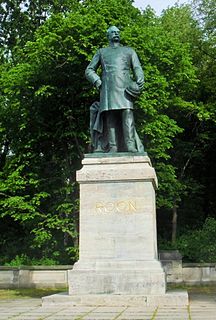
The statue of Albrecht von Roon is an outdoor 1904 monument to Albrecht von Roon by Harro Magnusson, installed in Tiergarten in Berlin, Germany.

The statue of Alexander von Humboldt by German sculptor Gustav Bläser is installed on Budapester Straße in Berlin-Tiergarten, Berlin, Germany.

Schlossbrücke is a bridge in the central Mitte district of Berlin, Germany. Built between 1821 and 1824 according to plans designed by Karl Friedrich Schinkel, it was named after the nearby City Palace (Stadtschloss). The bridge marks the eastern end of the Unter den Linden boulevard.

The statue of Helmuth von Moltke the Elder by Joseph Uphues is located near the Berlin Victory Column in the Tiergarten, Berlin.

A statue of Theodor Fontane by German sculptors Max Klein and Frtz Schaper is installed at Großer Tiergarten in Berlin, Germany.
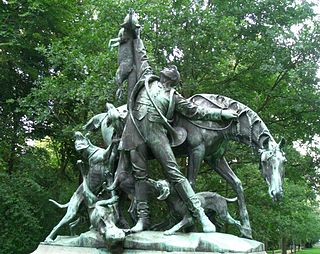
Churfürstliche Fuchsjagd, also known as Die Fuchsjagd zur Kaiserzeit or Zeitgenössische Fuchsjagd, is an outdoor 1904 sculpture by Wilhelm Haverkamp, installed at Fasanerieallee in the Tiergarten, Berlin, Germany.
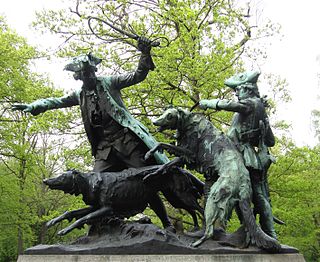
Hasenhatz zur Rokokozeit, or Hasenhatz der Rokokozeit, is an outdoor sculpture by Max Baumbach, installed at Fasanerieallee in the Tiergarten, Berlin, Germany.

Hunne zu Pferde is a sculpture by Erich Hösel, installed outside the Alte Nationalgalerie in Berlin, Germany.
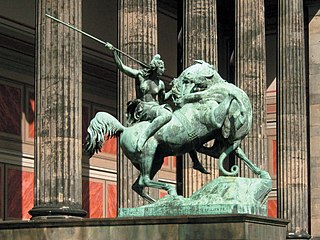
Amazone zu Pferde is an 1841 bronze equestrian statue by August Kiss, installed outside the Altes Museum in Berlin, Germany. It was based on a smaller clay model which August Kiss first built in 1839. Amazone zu Pferde stands opposite its companion statue, Löwenkämpfer.
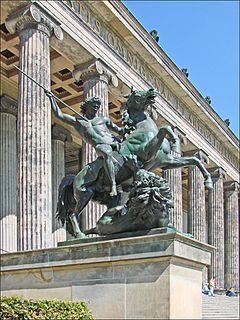
Löwenkämpfer is an 1858 bronze equestrian statue by Albert Wolff, installed outside the Altes Museum in Berlin, Germany. An 1892 copy stands in front of the Philadelphia Museum of Art. The companion piece is Amazone zu Pferde, also installed outside the Altes Museum.
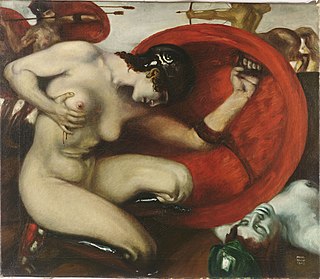
Wounded Amazon is a 1904 painting by the German artist Franz von Stuck. It depicts a kneeling and bleeding Amazon in a battle between Amazons and Centaurs.

The Berlin Bruisers are a gay and inclusive rugby club based in Berlin, Germany. They were founded in 2012, and are the first team of its kind in Germany. Although they are a primarily gay rugby team, the club is open to anyone with an interest in playing rugby and includes members of all sexualities and gender identities. The club is affiliated with International Gay Rugby.


















